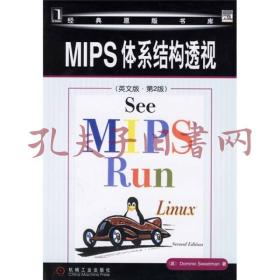
MIPS体系结构透视
¥ 18.5 2.8折 ¥ 65 八品
仅1件
河北衡水
认证卖家担保交易快速发货售后保障
作者[英]斯威特曼(Sweetman D.) 著
出版社机械工业出版社
出版时间2007-02
版次1
装帧平装
货号3-c8-2-5
上书时间2024-06-24
- 最新上架
商品详情
- 品相描述:八品
图书标准信息
- 作者 [英]斯威特曼(Sweetman D.) 著
- 出版社 机械工业出版社
- 出版时间 2007-02
- 版次 1
- ISBN 9787111206811
- 定价 65.00元
- 装帧 平装
- 开本 16开
- 纸张 胶版纸
- 页数 492页
- 丛书 经典原版书库
- 【内容简介】
-
大多数“体系结构概览”类的书籍最终都是对体系结构的汇编语言语焉不详,只是给出令人厌烦的概述。然而,本书却是一个典型的反例,它为所有这类书的作者树立了一个榜样。作者不但提供了体系结构参考所必需的细节,还以对关键体系结构特点(及其原理)富有洞察力的视角表达出这些细节。
无论是对通用的计算机体系结构来说,还是对于MIPS来说,本书都是非常有用的书籍。它阐述了渗入到体系结构发展中的技术、经济、历史等因素。
第2版的一个重要增加是涉及操作系统、移植以及ABI等问题,这使得本书对软件开发者来说也是一本优秀的参考书。任何从事MIPS体系结构相关工作的人都应该乐于拥有这本书。
第2版不仅对第1版进行了彻底的更新,而且还将应用广泛的RISC系统结构MIPS与开源操作系统Linux结合在了一起。本书的第一部分从MIPS设计原理开始,进而阐述了MIPS指令集和程序员资源。书中还以MIPS32/MIPS64标准为基准,对其他体系结构进行了比较。
与第1版相比,第2版的显著变化是封面图片——小企鹅坐在驾驶员的位置上,本书以此作为研究来自Linux内核的真正的低层操作系统的实例,并且展示Linux(包括单处理器和SMP)如何构建于MIPS体系结构所提供的基础之上。本书从操作系统的底层(中断、内存调度)开始,进而描述更高级的Linux/MIPS应用代码如何载入到内存、连接到库并运行。
●清晰地阐述了Linux如何在硬件上运行。
●提供了完整的、更新的和简单易用的MIPS指令集指南。
●本版保留了第1版可读性好的写作风格,凝聚了作者在基于MIPS体系结构的系统设计方面20多年的经验。 - 【作者简介】
- DominicSweetman。是一名有经验的硬件系统、CPU、网络和操作系统设计者和开发者,他的丰富经验来自于低层编码、操作系统开发、局域网、分布式系统。他是WhitechapelWorkstations的创立者之一,并在1988年创建了一家MIPS咨询公司——Algorithmics。
- 【目录】
-
Chapter1:RISCsandMIPS
1.1Pipelines
1.2TheMIPSFive-StagePipeline
1.3RISCandCISC
1.4GreatMIPSChipsofthePastandPresent
1.5MIPSComparedwithCISCArchitectures
Chapter2:MIPSArchitecture
2.1AFlavorofMIPSAssemblyLanguage
2.2Registers
2.3IntegerMultiplyUnitandRegisters
2.4LoadingandStoring:AddressingModes
2.5DataTypesinMemoryandRegisters
2.6SynthesizedInstructionsinAssemblyLanguage
2.7MIPSItoMIPS64ISAs:64-Bit(andOther)Extensions
2.8BasicAddressSpace
2.9PipelineVisibility
Chapter3:Coprocessor0:MIPSProcessorControl
3.1CPUControlInstructions
3.2WhatRegistersAreRelevantWhen?
3.3CPUControlRegistersandtheirencoding
3.4CP0Hazards?ATrapfortheUnwary
Chapter4:HowCachesworkonMIPS
4.1CachesandCacheManagement
4.2HowCachesWork
4.3Write-ThroughCachesinEarlyMIPSCPUs
4.4Write-BackCachesinMIPSCPUs
4.5OtherChoicesinCacheDesign
4.6ManagingCaches
4.7L2andL3caches
4.8CacheConfigurationsforMIPSCPUs
4.9ProgrammingMIPS32/64Caches
4.10CacheEfficiency
4.11ReorganizingSoftwaretoInfluenceCacheEfficiency
4.12CacheAliases
Chapter5:Exceptions,Interrupts,andInitialization
5.1PreciseExceptions
5.2WhenExceptionsHappen
5.3ExceptionVectors:WhereExceptionHandlingStarts
5.4ExceptionHandling:Basics
5.5ReturningfromanException
5.6NestingExceptions
5.7AnExceptionRoutine
5.8Interrupts
5.9StartingUp
5.10EmulatingInstructions
Chapter6:Low-levelMemoryManagementandtheTLB
6.1TheTLB/MMUhardwareandwhatitdoes
6.2TLB/MMURegistersDescribed
6.3TLB/MMUControlInstructions
6.4ProgrammingtheTLB
6.5Hardware-friendlypagetablesandrefillmechanism
6.6EverydayUseoftheMIPSTLB
6.7MemoryManagementinasimplerOS
Chapter7:Floating-PointSupport
7.1ABasicDescriptionofFloatingPoint
7.2TheIEEE754StandardandItsBackground
7.3HowIEEEFloating-PointNumbersAreStored
7.4MIPSImplementationofIEEE754
7.5Floating-PointRegisters
7.6Floating-PointExceptions/Interrupts
7.7Floating-PointControl:TheControl/StatusRegister
7.8Floating-PointImplementationRegister
7.9GuidetoFPInstructions
7.10Paired-singlefloating-pointinstructionsandMIPS3D.
7.11InstructionTimingRequirements
7.12InstructionTimingforSpeed
7.13InitializationandEnablingonDemand
7.14Floating-PointEmulation
Chapter8:CompleteGuidetotheMIPSInstructionSet
8.1ASimpleExample
8.2AssemblerInstructionsandWhatTheyMean
8.3Floating-PointInstructions
8.4DifferencesinMIPS32/64Release
8.5PeculiarInstructionsandTheirPurposes
8.6InstructionEncodings
8.7InstructionsbyFunctionalGroup
Chapter9:ReadingMIPSAssemblerLanguage
9.1ASimpleExample
9.2SyntaxOverview
9.3GeneralRulesforInstructions
9.4AddressingModes
9.5Objectfileandmemorylayout
Chapter10:PortingSoftwaretoMIPS
10.1Low-levelsoftwareforMIPS:AChecklistofFrequentlyEncounteredProblems
10.2Endianness:Words,Bytes,andBitOrder
10.3TroubleWithVisibleCaches
10.4Memoryaccessorderingandre-ordering
10.5WritingitinC
Chapter11:MIPSSoftwareStandards(?ABI?s)
11.1DataRepresentationsandAlignment
11.2ArgumentPassingandStackConventionsforMIPS?ABIs?
Chapter12:DebuggingMIPS-debugandprofilingfeatures
12.1The?EJTAG?onchipdebugunit
12.2Pre-EJTAGdebugsupport?breakinstructionandCP0Watchpoints
12.3PDTrace
12.4Performancecounters
Chapter13:GNU/LinuxfromEightMilesHigh
13.1Components
13.2Layeringinthekernel
Chapter14:Howhardwareandsoftwareworktogether
14.1Thelifeandtimesofaninterrupt
14.2Threads,criticalregionsandatomicity
14.3Whathappensonasystemcall384
14.4HowaddressesgettranslatedinLinux/MIPS
Chapter15:MIPS-specificissuesintheLinuxkernel
15.1ExplicitCacheManagement
15.2CP0Pipelinehazards
15.3Multiprocessorsystemsandcoherentcaches
15.4DemontweaksforaCriticalRoutine
Chapter16LinuxApplicationCode,PICandLibraries
16.1Howlinkunitsgetintoaprogram
16.2GlobalOffsetTable(?GOT?)organization
AppendixA:MIPSMultithreading
A.1WhatisMT
A.2WhyisMTuseful?
A.3HowtodoMTforaRISCarchitecture
A.4MTinaction
AppendixB:OtherOptionalextensionstotheMIPSinstructionset
B.1MIPS16andMIPS16e
B.2TheMIPSDSPASE440
B.3MDMX
MIPSGlossary
Index
点击展开
点击收起
相关推荐
— 没有更多了 —

























以下为对购买帮助不大的评价